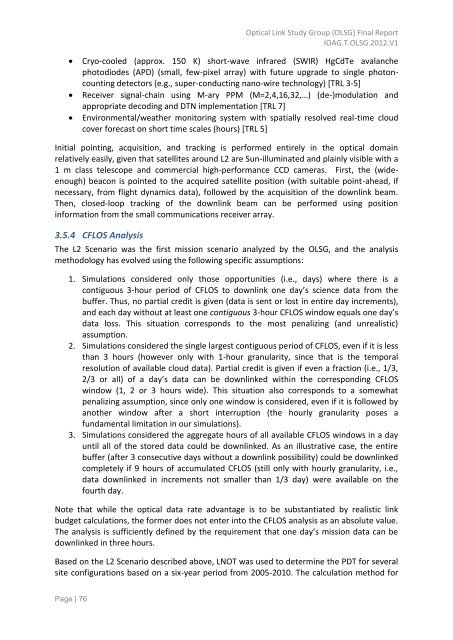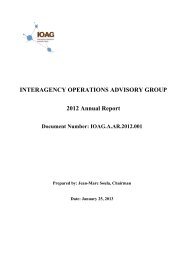OLSG Report_Final_06_05_12 - Interagency Operations Advisory ...
OLSG Report_Final_06_05_12 - Interagency Operations Advisory ...
OLSG Report_Final_06_05_12 - Interagency Operations Advisory ...
You also want an ePaper? Increase the reach of your titles
YUMPU automatically turns print PDFs into web optimized ePapers that Google loves.
Optical Link Study Group (<strong>OLSG</strong>) <strong>Final</strong> <strong>Report</strong><br />
IOAG.T.<strong>OLSG</strong>.20<strong>12</strong>.V1<br />
<br />
<br />
<br />
Cryo-cooled (approx. 150 K) short-wave infrared (SWIR) HgCdTe avalanche<br />
photodiodes (APD) (small, few-pixel array) with future upgrade to single photoncounting<br />
detectors (e.g., super-conducting nano-wire technology) [TRL 3-5]<br />
Receiver signal-chain using M-ary PPM (M=2,4,16,32,…) (de-)modulation and<br />
appropriate decoding and DTN implementation [TRL 7]<br />
Environmental/weather monitoring system with spatially resolved real-time cloud<br />
cover forecast on short time scales (hours) [TRL 5]<br />
Initial pointing, acquisition, and tracking is performed entirely in the optical domain<br />
relatively easily, given that satellites around L2 are Sun-illuminated and plainly visible with a<br />
1 m class telescope and commercial high-performance CCD cameras. First, the (wideenough)<br />
beacon is pointed to the acquired satellite position (with suitable point-ahead, if<br />
necessary, from flight dynamics data), followed by the acquisition of the downlink beam.<br />
Then, closed-loop tracking of the downlink beam can be performed using position<br />
information from the small communications receiver array.<br />
3.5.4 CFLOS Analysis<br />
The L2 Scenario was the first mission scenario analyzed by the <strong>OLSG</strong>, and the analysis<br />
methodology has evolved using the following specific assumptions:<br />
1. Simulations considered only those opportunities (i.e., days) where there is a<br />
contiguous 3-hour period of CFLOS to downlink one day’s science data from the<br />
buffer. Thus, no partial credit is given (data is sent or lost in entire day increments),<br />
and each day without at least one contiguous 3-hour CFLOS window equals one day’s<br />
data loss. This situation corresponds to the most penalizing (and unrealistic)<br />
assumption.<br />
2. Simulations considered the single largest contiguous period of CFLOS, even if it is less<br />
than 3 hours (however only with 1-hour granularity, since that is the temporal<br />
resolution of available cloud data). Partial credit is given if even a fraction (i.e., 1/3,<br />
2/3 or all) of a day’s data can be downlinked within the corresponding CFLOS<br />
window (1, 2 or 3 hours wide). This situation also corresponds to a somewhat<br />
penalizing assumption, since only one window is considered, even if it is followed by<br />
another window after a short interruption (the hourly granularity poses a<br />
fundamental limitation in our simulations).<br />
3. Simulations considered the aggregate hours of all available CFLOS windows in a day<br />
until all of the stored data could be downlinked. As an illustrative case, the entire<br />
buffer (after 3 consecutive days without a downlink possibility) could be downlinked<br />
completely if 9 hours of accumulated CFLOS (still only with hourly granularity, i.e.,<br />
data downlinked in increments not smaller than 1/3 day) were available on the<br />
fourth day.<br />
Note that while the optical data rate advantage is to be substantiated by realistic link<br />
budget calculations, the former does not enter into the CFLOS analysis as an absolute value.<br />
The analysis is sufficiently defined by the requirement that one day’s mission data can be<br />
downlinked in three hours.<br />
Based on the L2 Scenario described above, LNOT was used to determine the PDT for several<br />
site configurations based on a six-year period from 20<strong>05</strong>-2010. The calculation method for<br />
Page | 76



